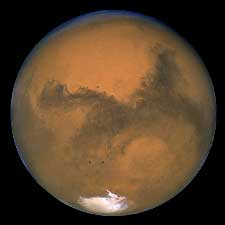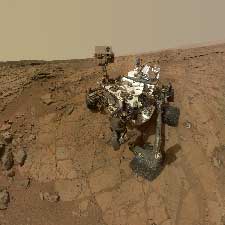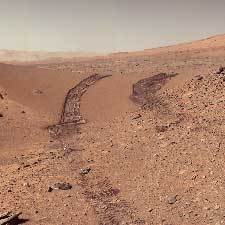Mars
Mars is the fourth terrestrial planet from the Sun and is commonly known as the “Red Planet” due to its reddish colour.
Both the ancient Greeks and Romans associated Mars with their gods of War, largely due to colour of the planet.
Mars has a thin atmosphere and many of the geological features on the surface of Mars are commonly found on Earth such as deserts, large valleys, volcanoes and even polar ice caps although they tend to be much larger.
For instance, the largest mountain recorded thus far on any planet can be found on Mars – the Olympus Mons which is 27 kilometres high and makes it three times as high as Mount Everest.
Missions to Mars
Is there life on Mars? This is a question that has been posed over the ages by astronomers and scientists across the world. Science fiction writers have written many novels about Mars and the existence of Martians, however, as one of the most studied planets in our solar system we have yet to find any evidence of the existence of life on Mars.
Mars was first observed via a spacecraft flyby by the Mariner 4 in 1965 and it is currently home to 7 manmade spacecraft. Five of these craft are currently in orbit around Mars – these are the Mars Odyssey, Mars Express, Mars Reconnaissance Orbiter, MAVEN and Mars Orbiter Mission and two craft are currently on the surface of Mars (Mars Exploration Rover Opportunity and the Mars Science Laboratory Curiosity).
The Mars Rover which landed on the surface of Mars in 2012 has led to some fascinating discoveries about Mars. It has long been questioned whether Mars is (or previously) able to support life. Although there is no sign of life currently, there is evidence that suggests that Mars previously could have supported life because the elements carbon, hydrogen, oxygen, phosphorus and sulphur are all present and are the building blocks of life.
There is also some evidence that there were ancient flows of water on the planet surface. The Mars Rover is still being operated on the surface of Mars by a team of scientists from NASA so it is possible that many more startling discoveries about Mars could be uncovered in the next year or two.
Mars Facts
Mars has two moons which are names Deimos and Phobos.
It is quite a small planet at roughly half the size of the Earth.
The average distance Mars is from the Sun is 228 million kilometres away. At its closest to the Sun it can be 205 million km away, whilst the furthest it will be during orbit of the Sun is around 249 million km.
A year on Mars would last 685 days, compared with 365 days on Earth. So even though a Martian year is nearly double that of an Earth year, a day on Mars lasts for 24 hours 39 minutes which is remarkably similar to that of an Earth day.
The average temperature on Mars is much colder than on Earth. On overage it is –60 degrees Celsius on Mars which is similar to what we would experience in Antarctica. But if you were to go to the poles on Mars the temperature would be as low as -125 degrees Celsius in the winter time.
Mars does have an atmosphere, but it is around 100 times less dense than the atmosphere on Earth. Nevertheless, it is still sufficient to be able to support weather systems on Mars and it has been observed by the Mars Rover currently on the planet surface that carbon dioxide snow clouds can form as well as common weather systems on the Earth such as wind, clouds and also a type of icy rain.
Mars is known as the Red Planet because of the reddish colour of the surface which is made up of iron minerals that oxidise (or rust) which gives the red colour.
The planet tilts on its axis (similar to Earth) which means there are areas on the planet that gain much more amounts of sunlight than others because it faces the Sun much more on that side and as such you can get Martian “seasons”. Although these seasons are much more variable than the seasons we find on Earth.
The planet is known to have violent dust storms that can last for months at a time and virtually cover the entire planet. It is thought that Mars has the harshest dust storms of any planet in our solar system.
Mars is known for its huge valleys and volcanoes. Valles Marineris is one of the largest valley regions on the planet and is composed of individual canyons that are up to 100 kilometres wide.
The largest crater on Mars is at Hellas Planitia and is 2,300 kilometres wide – this is one of around 42,000 craters that have currently been mapped on the surface of Mars.
Figures and Statistics
| Mars | Earth | Ratio (Planet to Earth) | |
| Rotation period - (hours) | 24.6229 | 23.9345 | 1.023 |
| Length of day - (hours) | 24.6597 | 24.00 | 1.027 |
| Length of year (earth days) | 779.96 | 365 | 2.137 |
| One complete orbit takes (earth days) | 687 | 365.256 | 1.881 |
| Radius (km) | 3396.2 | 6378.1 | 0.53 |
| Mass (1024 kg) | 0.642 | 5.9726 | 0.107 |
| Volume (1010 km3) | 16.318 | 108.321 | 0.151 |
| Density (kg/m3) | 3933 | 5514 | 0.713 |
| Distance from Earth - Min (106km) | 55.7 | - | - |
| Distance from Earth - Max - (106km) | 401.3 | - | - |
| Average distance from Sun (106km) | 227.9 | 149.6 | 1.523 |
| Orbital radius (106km) | 206.62 - 249.23 | 147-152 | 1.41 - 1.64 |
| Orbital velocity (average - km/s) | 24.07 | 29.78 | 0.808 |
| Rotational velocity (km/h) | 868.22 | 1674.4 | 0.519 |
| Surface gravity (m/s2) | 3.71 | 9.81 | 0.378 |
| Surface temp - Average (K) | 210 | 330 | 0.636 |
| Axial tilt (degrees) | 25.19 | 23.44 | 1.07 |
| Number of natural satellites (moons) | 2 | 1 | 2 |
-
Notes on the above figures:
- Orbits are invariably elliptical in nature. The average distance from the sun that appears above is also known as a 'semi-major axis', which is the mean (average) radius of the elliptical orbit.
- Axial tilt is also known as 'obliquity to orbit' and is the angle of rotation of the body itself with an imaginary line drawn through both poles, relative to its plane of orbit.
- Radius figures quoted are equatorial measurements. As most bodies exhibit 'oblateness' - that is to say that they appear slightly squashed - the radius from the centre to the poles would invariably be shorter.
- The Kelvin temperature scale is used for all temperature measurements above. 0K is equivalent to -273.15°C (degrees Celsius). To convert from K to C, simply subtract this figure from the Kelvin temperature given.
- Use of 'Index Notation' for very large numbers as above can be explained as follows; 106 = 10 x 10 x 10 x 10 x 10 x 10, or 1,000,000. For example, if you see a number that appears as 6x1011 then that number written in full would be 6 x 10 x 10 x 10 x 10 x 10 x 10 x 10 x 10 x 10 x 10 x 10 - or 600,000,000,000. Index notation allows us to write very big (or very small) numbers down far more concisely.


